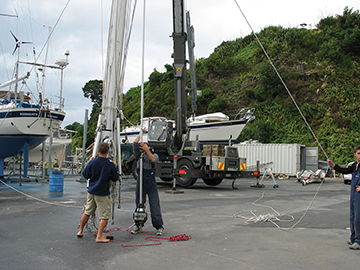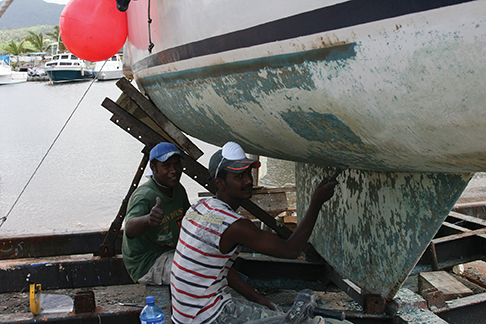She was a magnificent yacht in her day, and you’re the new proud owner. With a little tender loving care she can regain that youthful appearance, but, as with any new workout program, it doesn’t need to be accomplished in one undertaking (published February 2017)
Perhaps periodic routine maintenance by the previous owner has kept your new boat up to her potential. Perhaps not. The marine survey that you commissioned prior to the sale will provide you with some ideas, but a little time with your new boat will help you to refine those ideas and create a step by step process of refurbishment. By undertaking a minor refit, a more costly, time-consuming major refit may be avoided, delayed or modified as you get to know your new boat better. You might undertake a minor refit that could take the boat out of commission for a month to thoroughly check out the rig, install a new generator, and re-plumb the fuel system, or it may be time for an obvious major refit. In either case, the owner and the individual who is going to oversee the refit will need to make some decisions well in advance of tying up alongside in the yard.
 The first decision to be determined in any project is who is going to oversee the project. Someone has to manage the refit project, whether that is the owner, the vessel’s captain, a professional construction manager/consultant, or someone in the yard. “If the owner can, he would be well advised to manage the project himself”, an owner once told me. “After all, he is the one who needs to be satisfied with the job.” But that means being on site most of the time to properly control the project. Vessel owners may not always have the time, inclination or expertise to devote to the project, however, so it may become necessary to select a manager for the project.
The first decision to be determined in any project is who is going to oversee the project. Someone has to manage the refit project, whether that is the owner, the vessel’s captain, a professional construction manager/consultant, or someone in the yard. “If the owner can, he would be well advised to manage the project himself”, an owner once told me. “After all, he is the one who needs to be satisfied with the job.” But that means being on site most of the time to properly control the project. Vessel owners may not always have the time, inclination or expertise to devote to the project, however, so it may become necessary to select a manager for the project.
Often the task of overseeing the refit falls to the captain. I was cautioned, however, that this should only be the case if the jobs and the management to be undertaken are within the captain’s knowledge. He may be a good sea skipper, but if he’s not organized, the project can go on forever and get very expensive.
While the skipper may be the most familiar with the overall project and the goals of the owner, there may be some advantages to hiring a construction manager for a major refit. There are qualifications to this approach, however. Each person added to the program must benefit the program or it needlessly adds confusion and cost. Since there’s additional expense, there must be added value by the construction manager providing something that the captain or yard can’t.
Often it is difficult for captains of larger vessels to schedule their breaks around a busy itinerary for the vessel. If the captain prefers to remain on-site during the refit, he may be more able to incorporate his desires into the program, but he should have a boat building background to be able to fully contribute to the project. One well-known project manager mentioned a few more advantages to hiring a professional project manager, “Often the managers have established professional relationships with the various yards; they understand the facilities and strong points that they offer and how to get the best work done in the most efficient manner. Furthermore, they may be able to secure “trade prices” for the project and help to keep overall costs down.” He cautioned, however, that, “it’s necessary for the project manager and the owner to spend time together so that the owner can communicate his ideas and intentions to the project manager.”
Open communications throughout the project between the owner and his representative is of paramount importance to all parties involved. Years ago, during an earlier refit, the Vice President of Wayfarer Marine in Camden, Maine, said, “In my opinion, an owner having a major refit done on his boat, must have his own representative. At Wayfarer, we assign a yard manager to each project, but, in order to keep things going smoothly in the direction that the owner would like, it just doesn’t make sense for him not to have his representative. It helps communication and smooths out the entire administration of the project.”
Regardless of who the owner selects to oversee the project, they will need to select a yard, taking into consideration the intended work list, time frame, and the facilities that are available. The project manager mentioned, “There are many good, reputable yards throughout the U.S. capable of various refits. In addition to Wayfarer’s there’s Jamestown Boat Yard, Newport Shipyard, or New England Boatworks in Rhode Island, Hinckley’s in Rhode Island or Florida, and Pilot’s Point in Connecticut, but these are just a few. Before deciding on the yard, it’s often best to start with a thorough survey to determine what jobs will be necessary before the refit begins. Based on the owner’s desired changes and the necessary work, a yard can be selected taking into account the hull material if structural work in intended, where the best value is available, and which yards will provide the best “marriage” for the project.”
Some yards may be reluctant to allow work to be done by other than their own employees; most charge an access fee to either the outside contractor or the project. Understand the regulations prior to committing to a yard. One yard executive mentioned, “We’re happy to allow a set number of the crew to work on their boat, but the subcontractors need to work through the yard. Due to Worker’s Compensation laws and liability insurance, we’re forced to charge an hourly fee to the subcontractor to offset the cost.” Practices vary from yard to yard, so it may be necessary to research the topic prior to coming to an agreement with the yard. Are they going to charge the subcontractor, the project, or both?
 Subcontractor policies aren’t the only differences between yards. Hourly rates vary widely. Some yards vary their hourly rate a few dollars by the type of work. Other yards charge hourly rates usually “across the board”, but they may be more flexible in their rate structure during slow seasons. And to further complicate the rate structure, some states such as Conneticut have charged 6% tax on labor, while some states have not. That can lead to a significant difference in cost for a major refit. Most states levy a tax on material except for boats registered outside of the U.S. and leaving U.S. waters.
Subcontractor policies aren’t the only differences between yards. Hourly rates vary widely. Some yards vary their hourly rate a few dollars by the type of work. Other yards charge hourly rates usually “across the board”, but they may be more flexible in their rate structure during slow seasons. And to further complicate the rate structure, some states such as Conneticut have charged 6% tax on labor, while some states have not. That can lead to a significant difference in cost for a major refit. Most states levy a tax on material except for boats registered outside of the U.S. and leaving U.S. waters.
After the owner and his representative have determined an accurate work list and presented it to several suitable yards for pricing, the “ground rules” from yard to yard may still vary. Some yards will give binding quotes for specific types of jobs, others give estimates. Both project managers and yard executives agree that an estimate with some degree of flexibility (i.e. “not to exceed a certain price” or “not to exceed 10% over the original estimate”) may be the best route. Both Pilot’s Point Marina and Wayfarer’s have given binding quotes on deck replacements, repowering, or paint jobs—tasks that have relatively few hidden “nightmares”, but, I’ve been cautioned, “If a yard has given a firm bid on a complex job and starts to “get in trouble” on it, they may try to cut corners. The most important thing a yard must do, is thoroughly look at a boat before they are able to give an accurate bid.” Reputable yards will usually honor their original estimates and only increase the bills to their limit when absolutely necessary and justifiable to protect themselves from a loss.
Both captains and project managers represent the interests of the owner. A good Owner’s Representative understands the owner’s objectives. The owner may not need a particular job to be perfect; he may prefer that it be cost-effective. And in pursuit of the owner’s goals, yard executives see the perfect Owner’s Representative as someone who respects the vessel and the project, is organized, and can get the best out of the craftsmen, while giving them credit for their achievements. It’s a group effort, teamwork, with the vessel and the project as the beneficiaries.
To efficiently achieve the goals intended during the refit, the vessel manager should monitor the work being done by the project employees, the yard workers, and the outside contractors. Additionally, he will want to keep track of the materials being used. The records can be kept in the form of a brief daily log, and, while they may not be all-inclusive, the notes that are taken during the refit will help with both the scheduling of the work and any questions that may come up later when going over the final billing. The money saved through proper scheduling will more than offset the cost of taking the notes and planning ahead!
Building construction and retro-fitting has been made more efficient through the use of Critical Path Flow Charts or Microsoft’s Project Manager, a task and graphic analysis of a building schedule or project. The time chart indicates the earliest a particular phase of the project can begin. Several “paths” can be worked on simultaneously. During a refit, an unstepped mast can be broken down to its pieces, inspected, and reassembled while the main engine is being rebuilt. Working on different “paths” can be made more efficient by separating the work spaces: rigging shop, varnish shop, boat, work shed. People can be working in different areas so that they aren’t getting in each other’s way, but they are still close at hand to help if necessary. Some of the work can be done outside to keep costs down, and some of the work can be done inside to keep production up during rainy and winter periods. The flow chart exists by the axiom that “Time is money”; if the project manager can efficiently reduce the time spent in the refit, he can reduce the cost both to the yard and to the owner of the vessel.
To further reduce the time in the yard, adequate lead time needs to be allocated for ordering parts and completing pivotal jobs. To have a multi-million dollar investment sitting in a cradle for a couple of weeks waiting for a prop to be reconditioned is not a cost-effective use of time if that job could have been initiated at the start rather than at the completion of the refit. The organized manager plans ahead.
Good planning by the project manager may result in far greater cost savings to the project than having him actively participating in the actual work to be performed on the boat. Determining good, competitive prices, structuring an efficient work flow, and keeping track of the work completed and its billing may save the project thousands of dollars on a sizable refit. However, when his time permits, his help on the job can further reduce the cost of the project, give him insight into the problems being encountered on the boat, and provide additional motivation for the others working with the project. And when going over the final billing, his intimate knowledge of the entire refit will give him a thorough knowledge of the work that has been accomplished.
Going over the final bill should not be a confrontational exercise; yards are generally not given to unethical practices. By knowing how much a job is going to cost prior to its start, monitoring its progress throughout the refit, and dealing with problems as they arise, good communication is maintained, and the costs are understood and agreed upon. By supplying the invoices to the project manager for approval in advance of the final settlement, any differences can be explored and settled in a reasonable manner.
A well organized and executed refit is a “thing” of beauty: a choreography of people and tasks. At the end of it, the boat is the winner, and both the people at the yard and the crew employed by the owner should be justly proud.
Bill Biewenga is a navigator, delivery skipper and weather router. His websites are www.weather4sailors.com and www.WxAdvantage.com. He can be contacted at billbiewenga@cox.net

















